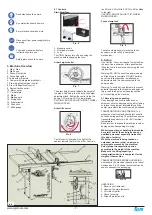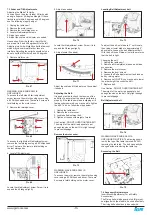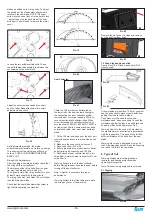
-6-
www.igmtools.com
up the workpiece and cause kickback when the
saw is restarted.
• Keep saw blades clean, sharp, and with
sufficient set. Never use warped saw blades or
saw blades with cracked or broken teeth. Sharp
and properly set saw blades minimise binding,
stalling and kickback.
4.8 Table saw operating procedure warnings
• Turn off the table saw and disconnect the
power cord when removing the table insert,
changing the saw blade or making adjustments
to the riving knife or saw blade guard,
and when the machine is left unattended.
Precautionary measures will avoid accidents.
• Never leave the table saw running
unattended. Turn it off and don’t leave the
tool until it comes to a complete stop. An
unattended running saw is an uncontrolled
hazard.
• Locate the table saw in a well-lit and level
area where you can maintain good footing and
balance. It should be installed in an area that
provides enough room to easily handle the size
of your workpiece. Cramped, dark areas, and
uneven slippery floors invite accidents.
• Frequently clean and remove sawdust from
under the saw table and/or the dust collection
device. Accumulated sawdust is combustible
and may self-ignite.
• The table saw must be secured. A table saw
that is not properly secured may move or tip
over.
• Remove tools, wood scraps, etc. From
the table before the table saw is turned
on. Distraction or a potential jam can be
dangerous.
• Always use saw blades with correct size and
shape (diamond versus round) of arbour holes.
Saw blades that do not match the mounting
hardware of the saw will run off-centre, causing
loss of control.
• Never use damaged or incorrect saw blade
mounting means such as flanges, saw blade
washers, bolts or nuts. These mounting means
were specially designed for your saw, for safe
operation and optimum performance.
• Never stand on the table saw, do not use
it as a stepping stool. Serious injury could
occur if the tool is tipped or if the cutting tool is
accidentally contacted.
• Make sure that the saw blade is installed
to rotate in the proper direction. Do not use
grinding wheels, wire brushes, or abrasive
wheels on a table saw. Improper saw
blade installation or use of accessories not
recommended may cause serious injury.
4.9 Electrical
• Machine plugs must match the outlet. Never
modify the plug in any way. Do not use any
adapter plugs with earthed (grounded) power
tools. Unmodified plugs and matching outlets
will reduce risk of electric shock.
• Disconnect the power first. Always disconnect
machine from power supply before adjusting,
changing tooling, or servicing machine.
• Power supply: 230V/50Hz/1 phase.
• Use a qualified electrician for all electrical
connections. Failure to do so may result in
damage to the tool and electrical shock to the
operator and bystanders.
• Power plugs. Your machine may not come
with a power plug because of the variance
in power receptacles. Consult with a local
electrician prior to purchasing a power plug.
Do not abuse the cord. Never use the cord for
carrying, pulling or unplugging the power tool.
Keep cord away from heat, oil, sharp edges
or moving parts. Damaged or entangled cords
increase the risk of electric shock.
• Extension cords. Consult with or use a
qualified electrician prior to sizing extension
cords for use with this machine.
• When operating a power tool outdoors, use an
extension cord suitable for outdoor use. Use of
a cord suitable for outdoor use reduces the risk
of electric shock.
• If operating a power tool in a damp location is
unavoidable, use a residual current device (rcd)
protected supply.
• Electrical protection. End user should connect
the machine to a circuit protected with a 16 A
circuit breaker, tripping characteristic C (16/1/C)
and overvoltage protection.
4.10 Noise emissions
•
Reference standards.
The measurements of noise emission were
conducted according to the EN ISO 11202:2010
for the determination of sound pressure level
at the operation positions. When the measured
sound pressure levels at the operation positions
exceed 80db(a), the measurements of sound
power levels were conducted according to EN
ISO 3746:2010.
•
Operating conditions.
The operating conditions for noise
measurement comply with Annex A of ISO
7960:1995.
•
Testing results:
A-weighted Sound Pressure - Level 91.3 dB
A-weighted Sound Power - Level 113.8 dB
Associated uncertainty - K=4dB
Background noise of measurement surrounding
is - 55dB
The figures quoted are emission levels and
are not necessarily safe working levels. Whilst
there is a correlation between the emission
and exposure levels, this cannot be used
reliably to determine whether or not further
precautions are required. Factors that influence
the actual level of exposure of the workforce
include the characteristics of the work room, the
other sources of noise etc. i.e. the number of
machines and other adjacent processes. Also
the permissible exposure level can vary from
country to country. This information, however,
will enable the user of the machine to make a
better evaluation of the hazard and risk.
4.11 Grounding
• Proper grounding of your machines lowers the
risk of injury by electricity.
• Avoid body contact with earthed or grounded
surfaces, such as pipes, radiators, ranges
and refrigerators. There is an increased risk
of electric shock if your body is earthed or
grounded.
• Do not modify the plug. Do not remove any of
the prongs attached to the proper plug for the
machine.
• Use only 3-wire extension cords.
Some extension cords only have two wires,
which does not allow for grounding.
• Always use grounded connections and work
only on a grounded circuit.
4.12 Rulings
Warning: Before connecting this tool to a
power supply (receptacle, outlet, etc.) Make
sure that the voltage supplied is the same
that is specified on the nameplate of the tool.
Also make sure that the power supply is
equipped with the appropriate breaker and
plug according to your local electrical code. If
in doubt, do not plug in the machine. Using this
tool with a voltage different than that stated
on the nameplate can damage the electrical
components of this machine and any such
damage will not be covered by a warranty.
Warning: Some dust created by power sanding,
sawing, grinding, drilling and other construction
activities contains chemicals known to cause
cancer, birth defects or other reproductive harm.
Some examples of these chemicals are:
• Lead from lead-based paint.
• Crystalline silica from bricks, cement, and
other masonry products.
• Arsenic and chromium from chemically treated
lumber.
Your risk of exposure varies, depending on how
often you do this type of work. To reduce your
exposure to these chemicals, work in a well-
ventilated area and work with approved safety
equipment, such as face or dust masks that are
specifically designed to filter out microscopic
particles.
4.13 Notice on safe use
The machinery sold by Laguna Tools,
distributed by IGM Tools and machinery co.,
are safe when used properly and comply to
with the CE norms, standards and regulations
for safe use. Laguna Tools or IGM is in no
way responsible for injury or death that occurs
while using this product. Your personal safety is
100% your responsibility and using this product
requires 100% of your attention.
If there is any concern related to the application
you are intending to use this tool for, DO NOT
proceed until you have contacted the retailer
you purchased it from and have been advised
on the correct application of the product.
This manual is intended to thoroughly cover
the setup up, maintenance, and proper
adjustments of your new purchase. Aside from
the proceeding general safety considerations,
this manual DOES NOT cover woodworking
or metalworking techniques that are possible
with this product and the appropriate safety
precautions necessary for safe practices. There
are several organizations with published safe
practices, techniques, and proper operation of
this tool.
Warning
The symbols below advise that you
follow the correct safety procedures when using
this machine.
Keep your fingers away from the
saw blade
Environmental protection:
Waste electrical products should not
be disposed of with household waste.
Please recycle where facilities exist.
Check with your local Authority or retailer for
recycling advice.







































